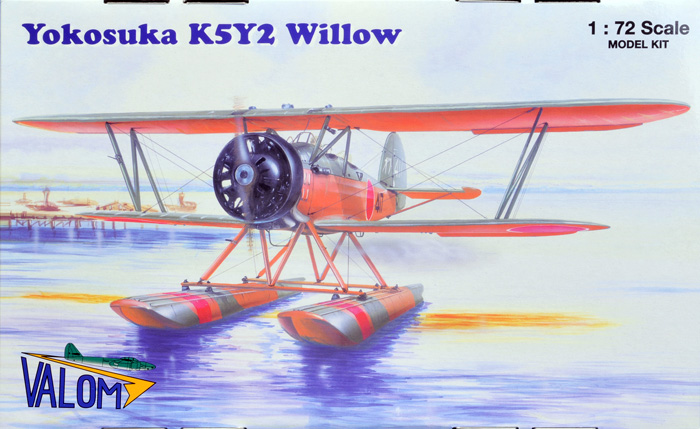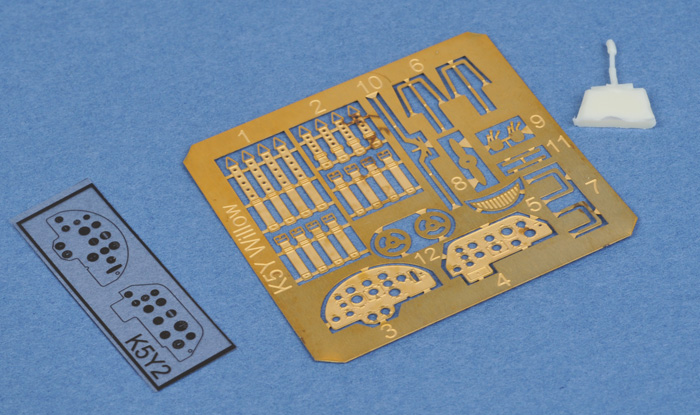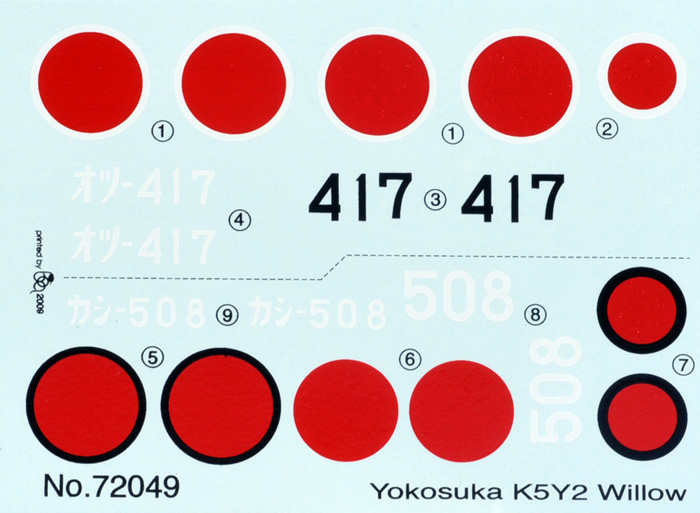|
Yokosuka K5Y2 Willow
Float Plane Version

Valom, 1/72 scale
S u m m a r y : |
Catalogue Number: |
Valom Kit Number 72049 - Yokosuka K5Y2 Willow Float Plane Version |
Scale: |
1/72 |
Contents & Media |
56 x grey styrene, 1x photo-etch fret (31 parts) plus photo negative instruments, 8 x clear styrene windshields, bombs, bomb-racks and gun; decals for two subjects, and 1 x cream resin control column. |
Price: |
Available on-line from Squadron for USD$ 25.19, Hannants Price TBA, and Modelimex Price 11.76 EUR |
Review Type: |
First Look |
Advantages: |
Superb surface detail, generally simple construction and good detail levels for the scale. |
Disadvantages: |
None worth mentioning |
Conclusions: |
A good kit of an interesting and attractive subject. |
Reviewed by Mark Davies

Valom's 1/72 scale Willow is available online from Squadron.com
Almost every air arm of the 1930’s and 40’s had a simple small biplane to provide intermediate pilot training. The Imperial Japanese Navy’s solution to this need was the Type 93 Yokosuka K5Y. Typical of the type, the K5Y was an attractively proportioned plane that entered service in 1934. Slightly less typically of the genre, the K5Y could be fitted with wheels or floats and carry a light bomb and gun armament.
Kawanishi developed the K5Y from Yokosuka’s earlier Type 91; this process improved the earlier design’s stability problems. Eight different manufacturers produced about 5,770. Given the Allied codename of Willow, the Japanese naval airmen called it aka-tombo meaning red dragonfly; no doubt in part from its usually bright orange colour as applied to most Japanese naval trainers.
The Willow saw wide service to the end of WW2 as the wheeled K5Y1, and two floatplane versions as the K5Y2 and K5Y3 (these having different versions of the same Amakaze engine). Like many training and utility types, the last Willows were prepared with explosives for Kamikaze missions in the event of the Japanese home islands being invaded.
I have the old LS kit of the K5Y (presumably also re-boxed by Arii), and I feel that this is still quite a good basis for a presentable model. But as this I found out through the review process, the Valom kit provides a big improvement over this earlier offering, particularly in terms of detail refinement, engine and decals.
The kit comes in a commendable and untypically Czech sturdy top-opening box. Attractive artwork on the front gives and immediate indication of the colourful possibilities this subject offers. Many other kit manufacturers, and not just the other Czech ones, could take a lesson from Valom on quality boxing.
The instructions provide a parts map, and an easy to follow diagrammatic assembly format. There is also a brief history of the aircraft. Text is in Czech and English.
The painting and decal guides are in 4-view form printed on glossy coloured paper. Again Valom outshines many other kit manufacturers with its approach to colour call-outs. These take the form of letter-coded coloured squares which are cross-references to the paint ranges of Humbrol, Agama, Model Master and Gunze Sanyo, and best of all to the Federal Standard 895b system. No less than 16 colours are referenced for this fairly simple kit.
I have most of Valom’s kit releases. There has been a clear improvement over the years with each release, and very high standards have been achieved in recent kits like the B-26 and Hampden. However, on removing the parts from their zip-lock plastic bag I was still immediately impressed by the excellent quality of the moulding in this kit. Not only are the styrene parts cleanly moulded limited-run items, but they have very nice surface detail with a restrained but authentic appearance to fabric covered and metal surfaces alike. The floats feature very delicate recessed riveting.
Detail parts are finely moulded with plenty of interior detail for the scale. This consists of moulded structure on the insides of the fuselage halves, floor panels, seats and control columns in styrene. There is also a single resin control column, although this does not seem to be mentioned in the instructions. This sub-assembly is enhanced by the PE fret that provides throttles, trim-wheels, seatbelts and control panels (these last having photo negative type instruments for added realism). Valom is to be commended for providing a clear detail drawing of the cockpit interior showing the relationship of throttles and trim wheels to the seats and interior structure, as these are often hard to determine from smaller constructional drawings.

A nicely moulded engine is provided, but will need scratch-built rod or stretched-sprue pushrods. Two exhaust collectors, a neatly moulded propeller and a two-part cowl round out the engine. Another good detail diagram shows the engine offset of 1.3 degrees to counter torque, again suggesting good research (In fact looking at photos and plans in Bunrindo’s book on the K5Y I must say Valom seem to have captured the aircraft very well).
The kit includes all parts for both the land and floatplane versions, so some legs and wheels will be destined for the spares box. This parts commonality has a bearing on the kit’s design of its upper wing, as will be covered below.
Construction sequence and parts breakdown is conventional for the type, except that the upper wing is in three parts requiring the builder to establish the dihedral on the two outer panels. This reflects a tooling economy on Valom’s part as the dihedral for the floatplane is 1.25 degrees, whereas the land-plane’s is 3 degrees. A three-piece wing enables the builder to achieve this level of accuracy (well done Valom on research), but a one-piece wing would be better and simpler for the builder – Either one moulding and forgo the dihedral difference, or supply a choice off upper wings. But this is not of major concern.
The bottom wings have a tabbed fit, something that is unusual for limited run kits and will be appreciated by many. The ailerons on both wings are separate items, although elevators and rudders aren’t (these latter items being easy to remove if needed by comparison to the ailerons).
The cabane struts locate by small pins in holes, whereas the inter-plane struts have longitudinal joiners between the forward and aft part of the “N” strut. These joiners fit into corresponding slots on the top surfaces of the bottom wings and undersurfaces of the top wing. This assembly method may present some challenges to hide the slots in the wing surfaces. Personally I would remove the joiners, fix them into the wings and fill and sand as necessary. Then I would locate the “N struts once the wings on the cabane struts and all is jigged in place.
Various small items like an optional wind-driven generator on the top wing (with PE prop) and a choice of PE or moulded boarding steps and an oil cooler with PE matrix finish the airframe off. The windscreens are clear and sufficiently delicate to be convincing. Interestingly the clear sprue also includes two small bombs, their racks and a machine gun with simple pivot mount. I think this use of clear styrene may be to enable simulation of the bomb fins bracing through careful painting, as these braces are moulded on the tail of each bomb as a solid square. I cannot figure out why the gun, its mount, or for that matter the bomb racks should be in clear however. Whatever their intention, Valom seem to have dropped the ball a little here, as the gun is rather simple and almost clunky - a nice resin offering or at leat PE handle and sights would have been worthwhile. The bombs could have benefited from PE fins as well. Fortunately Willows were often unarmed, and if you want better armament it’s easy enough to scratch-build some; so no real loss here.

The marking options are both quite attractive IJNAF green over orange schemes. A bit of research will throw up other attractive options as well.

The decals appear to be well printed with good opacity.
This is a very nice limited run kit of an attractive 1930’s trainer. Japanese subjects are not always the most popular in many. However I’m sure there will be many who still have the old LS Willow that will be tempted to update with this significantly improved offering from Valom.
Thanks to Valom for this review
sample.
Review Text Copyright © 2009 by Mark Davies
Images Copyright © 2009 by Brett Green
Page Created 24 April, 2008
Last updated 24 April, 2008
Back to HyperScale Main Page
Back to Reviews Page |
